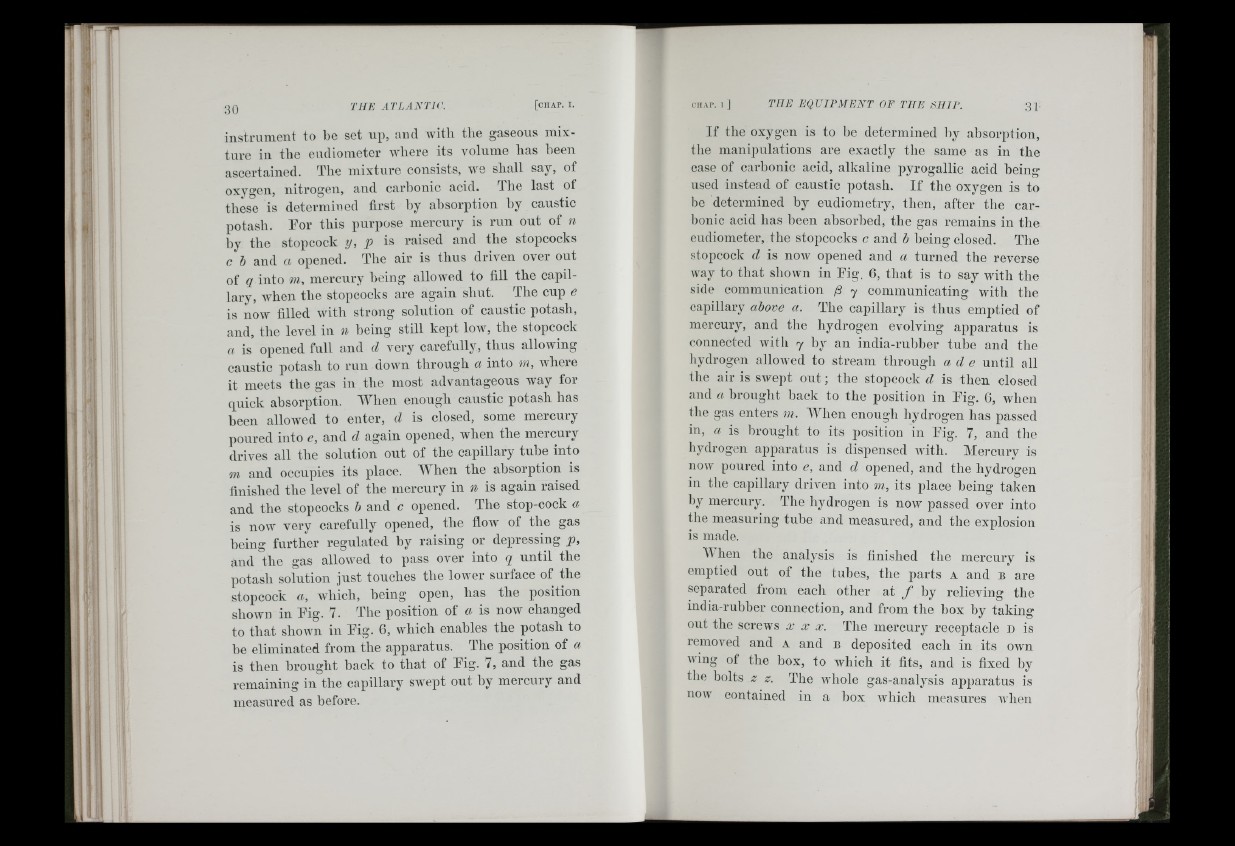
i ,,
instrument to 1)C set up, and witli tlie gaseous mixture
in the eudiometer Avliere its volume has heen
ascertained. The mixture consists, Ave shall say, of
oxygen, nitrogen, and carhonic acid. The last of
these is determined first hy absorption hy caustic
potash. Tor this purpose mercury is run out of n
hy the stopcock y, p is raised and the stopcocks
c b and a opened. The air is thus driven over out
of q into m, mercury heing allowed to fill the capillary,
Avhen the stopcocks are again shut. The cup
is noAV filled Avith strong solution of caustic potash,
and, the level in n heing still kept Ioav, the stopcock
a is opened full and d very carefully, thus allowing
caustic potash to run down through a into m, Avhere
it meets the gas in the most advantageous way for
quick absorption. When enough caustic potash has
heen alloAved to enter, d is closed, some mercury
poured into e, and d again opened, when the mercury
drives all the solution out of the capillary tube into
m and occupies its place. When the absorption is
finished the level of the mercury in n is again raised
and the stopcocks b and c opened. The stop-cock a
is now very carefully opened, the floAV of the gas
heing further regulated hy raising or depressing p,
and the gas alloAved to pass over into q until the
potash solution just touches the lower surface of the
stopcock a, Avhich, heing open, has the position
shown in Eig. 7. The position of a is now changed
to that shoAvn in Eig. 6, wffiich enables the potash to
he eliminated from the apparatus. The position of a
is then brought back to that of Eig. 7, and the gas
remaining in the capillary sw’cpt out hy mercury and
measured as before.
If the oxygen is to he determined hy absorption,
the manipulations are exactly the same as in the
case of carbonic acid, alkaline pyrogallic acid being
used instead of caustic potash. I f the oxygen is to
he determined hy eudiometry, then, after the carhonic
acid has been absorbed, the gas remains in the
eudiometer, the stopcocks c and b heing closed. The
stopcock d is noAv opened and a turned the reverse
way to that sliown in Eig, 6, that is to say Avith the
side communication ¡3 j communicating with the
capillary above a. The capillary is thus emptied of
mercury, and the hydrogen evolving apparatus is
connected with y by an india-ruhher tube and the
hydrogen alloAved to stream through a d e until all
the air is swept o u t; the stopcock d is then closed
and a brought back to the position in Eig. 0, when
the gas enters m. When enough hydrogen has passed
in, a is brought to its position in Eig. 7, and the
hydrogen apparatus is dispensed Avith. Mercury is
noAv poured into e, and d opened, and the hydrogen
in the capillary driven into m, its place heing taken
hy mercury. The hydrogen is now passed over into
the measuring tuhe and measured, and the explosion
is made.
M hen the analysis is finished the mercury is
emptied out of the tubes, the parts A and b are
separated from each other at f by relieving the
india-rubber connection, and from the box by taking
out the screws x x x. The mercury receptacle d is
removed and a and b deposited each in its OAvn
wing of the box, to Avhich it fits, and is fixed by
the bolts 2; The Avhole gas-analysis apparatus is
noAv contained in a box Avhicli measures Avlien